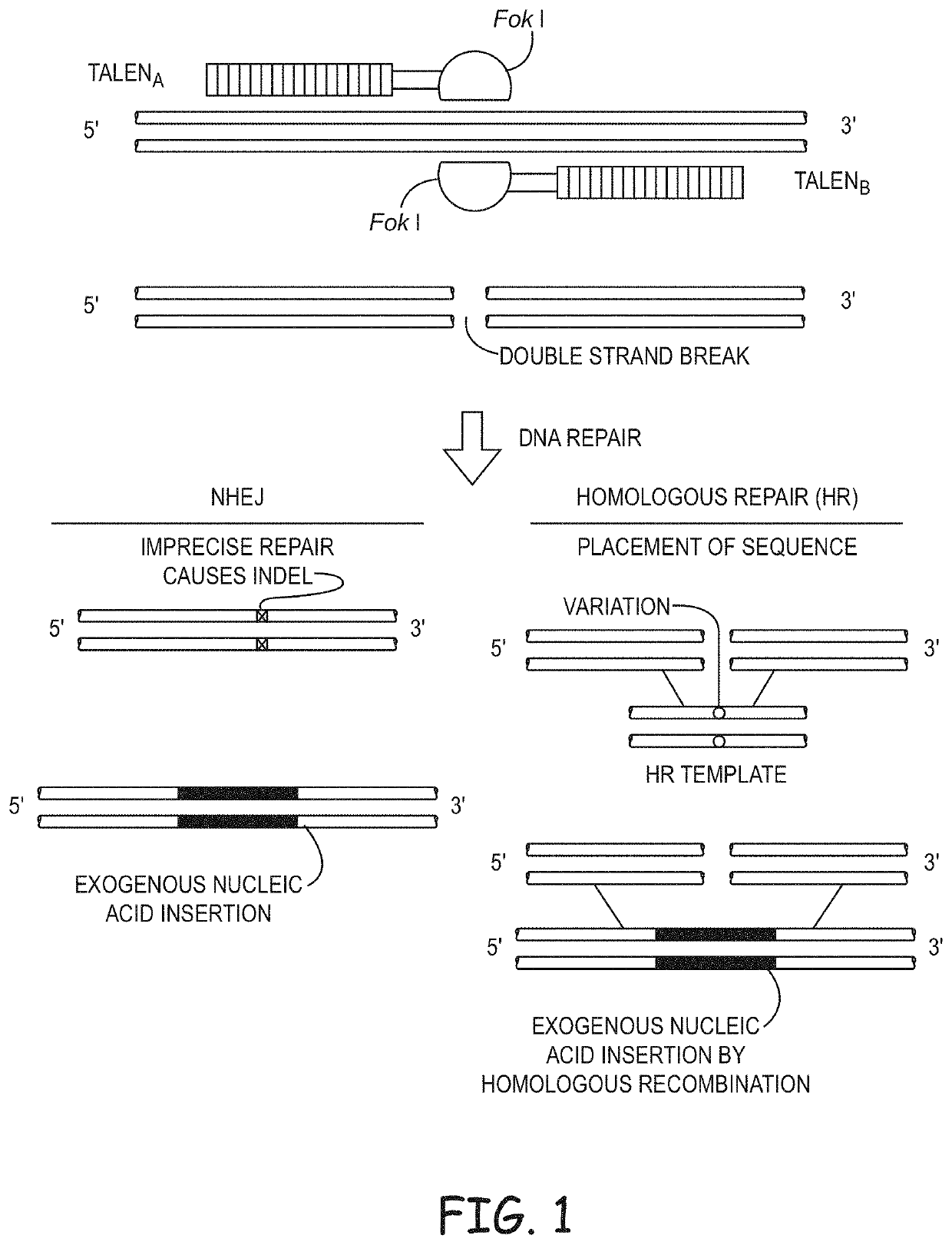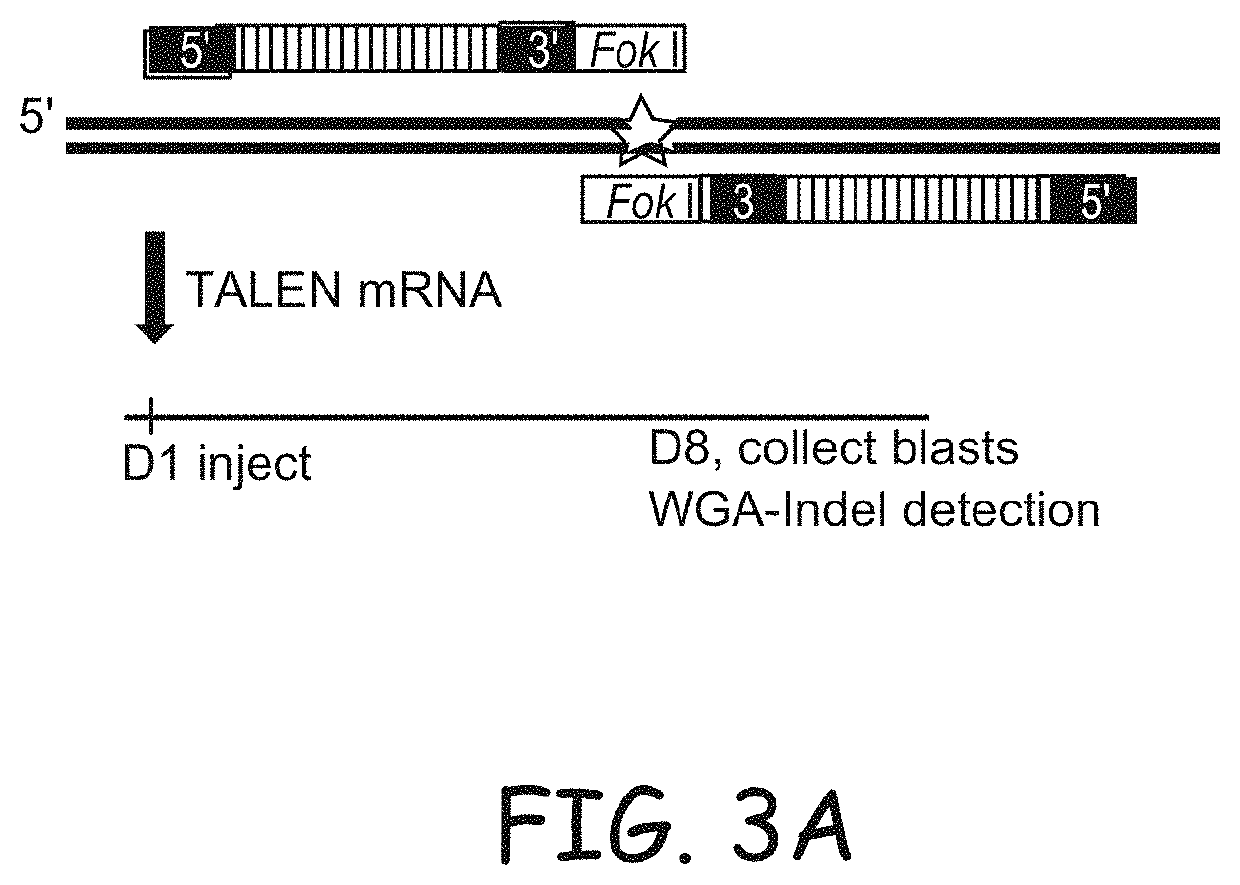Non-meiotic allele introgression
a technology of alleles and introgression, applied in the field of non-meiotic allele introgression, can solve the problems of low efficiency, unpredictable expression, human risk,
- Summary
- Abstract
- Description
- Claims
- Application Information
AI Technical Summary
Benefits of technology
Problems solved by technology
Method used
Image
Examples
example 1
Genetically Modified Artiodactyl Livestock (Bovine) Produced by Direct Injection of TALENs
[0381]Three TALEN pairs were designed and assembled as described in Cermak et. al. (2011) Nuc. Acids Res. 39:e82 (FIG. 3) and mRNA was injected into the cytoplasm of bovine embryos at about 19 hours post fertilization. The ACAN gene was targeted. Aggrecan Proteoglycan (ACAN) is an extracellular matrix protein that can be found in cartilagenous tissues. Mutations of the ACAN gene are known to cause dwarfism in both dogs and cattle. More particularly, bulldog dwarfism in Dexter cattle is caused by mutations in ACAN. Bulldog dwarfism in Dexter cattle is one of the earliest single-locus disorders described in animals. Affected fetuses display extreme disproportionate dwarfism, reflecting abnormal cartilage development (chondrodysplasia). Typically, they die around the seventh month of gestation, precipitating a natural abortion. Heterozygotes show a milder form of dwarfism, most noticeably having s...
example 2
Genetically Modified Artiodactyl Livestock Produced by Genetic Modification of Bovine and Swine Somatic Cells
[0383]Several additional TALEN pairs were assembled as described in Cermark et al. (2011) Nuc. Acids Res. 39:e82 for targets in pigs and cattle chosen based on either biomedical or agricultural relevance, such as DMD. Mammalian animal models have proven invaluable in defining the complexity of muscle disease and have enabled the development of several promising therapeutic strategies for Duchenne Muscular Dystrophy (DMD). However, the development of regenerative therapies would greatly benefit from more faithful and reproducible models. Muscle degeneration in the mdx mouse model is mild in comparison to DMD patients, perhaps due to smaller muscle forces in rodents, or because of partial functional redundancy. Several dystrophin-deficient dogs have been identified and the causative genetic lesion defined in at least three. The best-characterized and closest in phenotype to DMD...
example 3
Extended Culture and Indel Enrichment by Transposon Co-Transfection
[0386]TALEN pairs were transfected into fibroblasts and cultured cells for 14+ days with or without transposon co-selection prior to measurement of modification levels. The targeted genes include bovine GDF8 (btGDF8), Bovine ACAN (ACAN12), Porcine DMD (DMDE7.1 (A); DMDE6 (TALENs targeted to exon 6 of the DMD gene.)), Porcine LDLR (C) (LDLR2.1) (see Tables 13 and 14). The results are summarized in FIG. 7, panel C. At day zero (D0), cells are transfected with a mixture of plasmids including an expression cassette for each TALEN (two plasmids), a transposon encoding a selection marker (a third plasmid, encoding puromycin, and a transposase-expression cassette (fourth plasmid). The TALEN plasmids are the main component (4-fold excess by mass) of each transfection. Transfected cells are cultured for 3 days at either 30 or 37° C. prior to splitting, collection of a sample for SURVEYOR assay and re-plating for extended cult...
PUM
 Login to View More
Login to View More Abstract
Description
Claims
Application Information
 Login to View More
Login to View More - R&D Engineer
- R&D Manager
- IP Professional
- Industry Leading Data Capabilities
- Powerful AI technology
- Patent DNA Extraction
Browse by: Latest US Patents, China's latest patents, Technical Efficacy Thesaurus, Application Domain, Technology Topic, Popular Technical Reports.
© 2024 PatSnap. All rights reserved.Legal|Privacy policy|Modern Slavery Act Transparency Statement|Sitemap|About US| Contact US: help@patsnap.com










